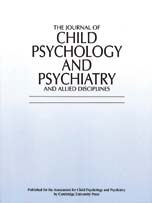Annotation: Do Measures of Externalising Behaviour in Normal Populations Predict Later Outcome?: Implications for Targeted Interventions to Prevent Conduct Disorder
Published online by Cambridge University Press: 01 November 1998
Abstract
Mental health professionals involved with the care of children and adolescents are frequently confronted with questions about the risk of later troublesome outcomes. Of particular concern is whether the presence of certain risk factors warrants the provision of an intervention. The presence of externalising behaviour symptoms is regarded by many as the single best predictor of risk for future conduct disorder and antisocial behaviour (Loeber, 1991; Lynam, 1996; Moffitt, 1993; Patterson, 1993; Yoshikawa, 1994). These symptoms include aggression against others, destruction of the personal property of others, temper tantrums, and noncompliance, to name but a few. The evidence suggests that when these behaviours are present in childhood there is an increased risk for persistent, life-long psychosocial problems (Loeber, 1982; Loeber & Dishion, 1983; Moffitt, 1993; Olweus, 1979; Yoshikawa, 1994). For example, a link between the early onset of externalising behaviours and the later development of conduct disorder, antisocial behaviour, and substance abuse has been documented in both longitudinal and retrospective studies (Caspi, Moffitt, Newman, & Silva, 1996; Farrington, 1990; Robins, 1978; Tremblay, Pihl, Vitaro, & Dobkin, 1994; White, Moffitt, Earls, Robins, & Silva, 1990; Zoccolillo, Tremblay, & Vitaro, 1996).
The risks associated with externalising symptoms and the relatively modest effectiveness of treatment for established cases of conduct disorder and antisocial behaviour (Kazdin, 1997; Offord, 1989; Offord & Bennett, 1994) have led to an increased emphasis on the provision of preventive interventions (Institute of Medicine, 1994; Reiss & Price, 1996). It has been argued that intervention should be provided to high-risk children as early as possible. Claims have been made that even in nonclinic populations of children as young as 4 and 5 years of age, 50% or more of those with troublesome externalising symptoms will develop persistent psychosocial problems (Campbell, 1995; Coie, 1996; Reid, 1993; Reid & Patterson, 1991).
- Type
- Review Article
- Information
- The Journal of Child Psychology and Psychiatry and Allied Disciplines , Volume 39 , Issue 8 , November 1998 , pp. 1059 - 1070
- Copyright
- © 1998 Association for Child Psychology and Psychiatry
- 59
- Cited by


